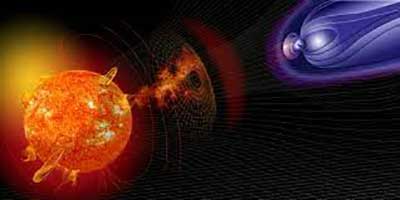Relevance: GS-3: Important Geophysical phenomena
Key phrases: CLASS, solar proton events, ISRO, CMEs, NASA's, Solar flares, M1 flare, Chandrayaan-2 mission.
Why in News?
- A Large Area Soft X-ray Spectrometer (CLASS), a payload on-board Chandrayaan-2 Orbiter, has detected solar proton events (SPEs) which significantly increase radiation exposure to humans in space, the Indian Space Research Organisation (ISRO) said on Wednesday.
Context:
- Chandrayaan-2 Large Area Soft X-ray Spectrometer (CLASS) on-board Chandrayaan-2 Orbiter detected SPE due to an M5.5 class solar flare that occurred on January 20, 2022. The CLASS instrument also detected a CME event as it passed through the moon due to an M1.5 class solar flare that occurred on January 18.
- CME travels at a speed of about 1,000 km/s and it takes about 2-3 days to reach the Earth.
- The signature of this event is missed by the GOES satellite NASA, as Earth's magnetic field provides shielding from such events. However, the event was recorded by Chandrayaan-2. The CLASS payload on Chandrayaan-2 saw both the SPE and CME events pass by from two intense flares on the Sun.
- The instrument on January 18 also recorded coronal mass ejections (CMEs), a powerful stream of ionised material and magnetic fields, which reach the Earth a few days later, leading to geomagnetic storms and lighting up the polar sky with auroras, it said.
- Such multi-point observations help us understand the propagation and its impact on different planetary systems.
- The SPE event was seen by NASA's Geostationary Operational Environmental Satellite (GOES) satellite orbiting around Earth. However, the CME event was not detected by GOES.
What is Solar flare?
- When the Sun is active, spectacular eruptions called solar flares occur that sometimes also spew out energetic particles (called Solar Proton Events or SPEs) into interplanetary space. Most of these are high energy protons that impact space systems and significantly increase radiation exposure to humans in space. They can cause ionisation on large scales in Earth's middle atmosphere.
- Many intense solar flares are accompanied by CMEs, a powerful stream of ionised material and magnetic fields, which reach the Earth a few days later, leading to geomagnetic storms and lighting up the polar sky with auroras.
- Solar flares are classified according to their strength. The smallest ones are A-class, followed by B, C, M and X. Each letter represents a 10-fold increase in energy output. This means that an M class flare is ten times more intense than C-class flare and 100 times intense than B-class flare.
- Within each letter class there is a finer scale from 1 to 9 - a M2 flare is twice the strength of M1 flare.
- Recently, there were two M-class solar flares. One flare (M5.5) spewed out energetic particles into interplanetary space and the other flare (M1.5) was accompanied by a Coronal Mass Ejection (CME).
-
Chandrayaan-2 mission is a highly complex mission, which represents a significant technological leap compared to the previous missions of ISRO, which brought together an Orbiter, Lander and Rover with the goal of exploring south pole of the Moon. This is a unique mission which aims at studying not just one area of the Moon but all the areas combining the exosphere, the surface as well as the sub-surface of the moon in a single mission.
-
Planned to land on the South Pole of the Moon, Chandrayaan-2 was launched on July 22, 2019. However, the lander Vikram hard-landed on September 7, 2019, crashing India's dream to become the first nation to successfully land on the lunar surface in its maiden attempt.
-
CLASS on Chandrayaan-2 aims to map the abundance of elements on the lunar surface using XRF during solar flare. The instrument uses large area SCDs and is designed to provide better spatial resolution and sensitivity than the C1XS experiment on Chandrayaan-1.
Effects of Solar flare or Solar proton events on Earth:
- Not all solar flares reach Earth, but solar flares/storms, solar energetic particles (SEPs), high-speed solar winds, and coronal mass ejections (CMEs) that come close can impact space weather in near-Earth space and the upper atmosphere.
- Solar storms can hit operations of space-dependent services like global positioning systems (GPS), radio, and satellite communications. Geomagnetic storms interfere with high-frequency radio communications and GPS navigation systems. Aircraft flights, power grids, and space exploration programmes are vulnerable. Ex. A geomagnetic storm triggered by a large burst of radiation from the sun has disabled at least 40 of the 49 satellites newly launched by SpaceX as part of its Starlink internet communications network.
- Energetic protons released by a CME can cause an increase in the number of free electrons in the ionosphere, especially in the high-latitude Polar Regions. The increase in free electrons can enhance radio wave absorption, especially within the D-region of the ionosphere, leading to polar cap absorption events.
- Effective and high electrical currents that come along the Earth’s surface at the time of auroral events disrupt electric power grids. Ex. A CME caused a power failure in Québec, as well as across parts of the north eastern U.S. In this event, the electrical supply was cut off to over 6 million people for nine hours.
Way forward:
- These are the natural phenomenon and we cannot stop it. Prediction and prevention is the only option to reduce the effect of these storms.
- For example at the Space Weather Prediction Center – continually monitor the sun, both from space and from Earth’s surface. When a solar storm with the potential to affect Earth takes place, they see it and rises an alert.
- Governments and scientists are beginning to pay more attention to this issue, with an eye to creating systems and procedures to help withstand such powerful effects from the sun.
Source: The Hindu BL
Mains Question:
Q. What are the solar proton events (SPEs)? How do such events represent a threat to modern society. Critically analyse. (250 words).







